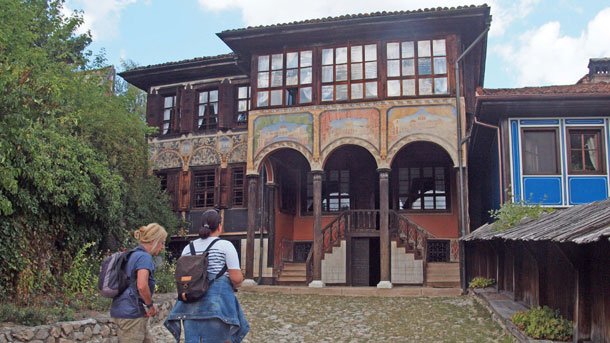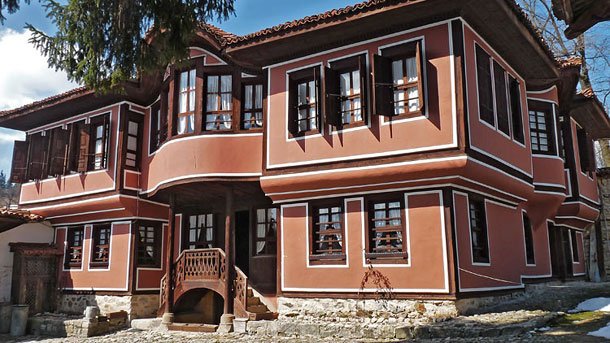
Koprivshtitsa is a picturesque mountain town, lingering at the foot of the Sredna Gora Mountain. There is hardly a Bulgarian who has been to Koprivshtitsa only once in their lives. Getting a first-hand experience of the houses, cobblestone streets, fountains and people there lends you the feeling of traveling back in time. It is no accident then that Koprivshtitsa has been called a museum-town. Only for a day here you can get a tour of seven houses of prominent Bulgarians from the National Revival period whose lives were closely associated with the struggle of the Bulgarian people for liberation from Ottoman rule. Today, these houses have been turned into museums with their own authentic expositions. The Oslekova House, the museums of poet Dimcho Debelyanov, writer Lyuben Karavelov revolutionaries Todor Kableshkov and Georgi Benkovski, the Lyutova house - they are all priceless architectural monuments and treasures of our country. Town guests do not miss to visit the Palaveev houses architectural complex where ever there are exhibitions of paintings from the museum dedicated to Koprivshtitsa, and among them paintings by contemporary Bulgarian authors.

© Photo: BGNES
"Koprivshtitsa is very inviting with its nature and architecture in every season of the year," says Elena Zhelyazkova - tour guide at the Directorate of Museums in Koprivshtitsa.
“Koprivshtitsa is so rich in history that it is difficult to cover everything in one tour. People are interested in the remarkable figures in Koprivshtitsa and its architecture, but first and foremost in the events that happened here. Despite the economic crisis, many tourists come who are fascinated by our town. Some time ago, a guest from America wrote to us that if this city wasin the U.S., it would be placed under a bell jar, because it has a lot of valuable things. During the folklore fair held in the area around Koprivshtitsa we can meet people who appreciate Bulgaria’s vocal and dance heritage. Each year the patriotic mood fills the streets when doing a re-enactment of the events of the outbreak of the April Uprising back in 1876. In these times people forget about their everyday problems and start living within the history and spirit of the festive events in the past. In the town there are two ethnographic museums: the Oslekova and Lyutova houses. The buildings date back to the Crimean War (1853-1856) with beautiful architecture, and are characterized by rich murals and indoor salons in place of the earlier open verandas. There, visitors are introduced to the former lifestyle in Koprivshtitsa. In the Lyutova house, which is among the most valuable monuments in the town, now there's something you rarely see in other parts of the country. This is the exhibition of the typical Koprivshtitsa felt, non-woven carpets, whose masters have reached here a very high skill in their decoration, while in other parts they have been done with much simpler craftsmanship. It is true that we live in a museum town and often people are often joking with us, saying that locals have turned into museum exhibits themselves. That's because the town gets depopulated. Sometimes it seems that we are living in the distant past as the peace and tranquility that exists here is something rarely seen in other cities in Bulgaria. Koprivshtitsa keeps the memory of the great local families Moravenovs, Chipevs, Chomakovs and descendants of the Kableshkovs, Karavelovs as some of their descendants still live in our town,” says Elena Jelyazkova.

© Photo: www.koprivshtitza.com
One of the most beautiful Revival Period houses that leaves a lasting impression in the minds during a quick tour of museums in Koprivshtitsa is the home of Bulgarian revolutionary Todor Kableshkov. Raina Pacheva has devoted her life to this house, she is the curator and every day she tells Kableshkov’s turbulent story to the curious visitors.
"What is little known about Todor Kableshkov and what people often find out only after they come to Koprivshtitsa is that he pioneered the translation of the novel "The Count of Monte Cristo" from French into Bulgarian. This is the first translation that was done, but remained unfinished because of the events during the struggle for liberation. Since Kableshkov studied in the French College in Istanbul, he learnt three languages - Turkish, French, and Greek. He was much in solidarity with the struggle of the French people, with the French Revolution. He even attended college with a red tie, in solidarity with the revolution. When people visit his house, they see that he came from a wealthy family. Many visitors often ask the question - what did young Todor miss in order to decide to join the struggle against the Ottomans? And this is the question that Selyami Pasha asked him when he was caught in the Troyan Balkan, which Kableshkov answers – “I cannot just sit and watch how my people is suffering, all the neighboring nations earned their freedom, only we are still your slaves”. Because of this sincerity he Pasha locked Kableshkov in the zaptieh’s room in the Gabrovo konak (town hall), not in the cell for insurgents. There Kableshkov, taking by surprise the guard, took his gun and put an end to his own life. He died only 25-years-old. Tourists are also impressed by the architecture of Kableshkov’s house, which is one of the most exquisite in the town. One room has a ceiling covered with carvings all over - a true masterpiece."
English version: Rossitsa Petcova
In its centuries-old history, the Etropole Monastery "Holy Trinity", also called "Varovitets", has been preserving valuable pages decorated by skilled artists. Here hundreds of years ago, one of the most productive literary schools in Bulgarian..
Cape Kaliakra is one of the most picturesque places along Bulgaria’s Black Sea coast. The narrow rocky peninsula cuts 2 kilometers through the sea. Its steep slopes are 60-70 meters high. The waves have cut deep niches and caves..
As a result of glacial erosion during the Quaternary era, clusters of lakes were formed in the higher reaches of Rila Mountain, an essential element of the landscape. The string of the seven lakes of Rila is the longest, most scenic and most..

+359 2 9336 661
